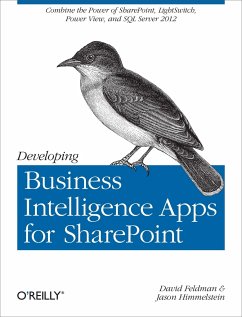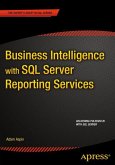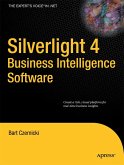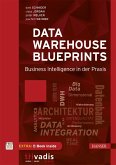David Feldman, Jason Himmelstein
Developing Business Intelligence Apps for SharePoint
Combine the Power of Sharepoint, Lightswitch, Power View, and SQL Server 2012
David Feldman, Jason Himmelstein
Developing Business Intelligence Apps for SharePoint
Combine the Power of Sharepoint, Lightswitch, Power View, and SQL Server 2012
- Broschiertes Buch
- Merkliste
- Auf die Merkliste
- Bewerten Bewerten
- Teilen
- Produkt teilen
- Produkterinnerung
- Produkterinnerung
Create dynamic business intelligence (BI) solutions for SharePoint faster and with more capabilities than previously possible. With this book, you’ll learn the entire process—from high-level concepts to development and deployment—for building data-rich BI applications with Visual Studio LightSwitch, SQL Server 2012, and a host of related Microsoft technologies. You’ll learn practical techniques and patterns necessary to use all of these technologies together as you build an example application through the course of the book, step by step. Discover how to solve real problems, using BI solutions…mehr
Andere Kunden interessierten sich auch für
![Business Intelligence with SQL Server Reporting Services Business Intelligence with SQL Server Reporting Services]() Adam AspinBusiness Intelligence with SQL Server Reporting Services47,99 €
Adam AspinBusiness Intelligence with SQL Server Reporting Services47,99 €![Silverlight 4 Business Intelligence Software Silverlight 4 Business Intelligence Software]() Bart CzernickiSilverlight 4 Business Intelligence Software39,99 €
Bart CzernickiSilverlight 4 Business Intelligence Software39,99 €![Data Warehouse Blueprints Data Warehouse Blueprints]() Dani SchniderData Warehouse Blueprints42,00 €
Dani SchniderData Warehouse Blueprints42,00 €![Open Source Business Intelligence Open Source Business Intelligence]() Sebastian StrugholtzOpen Source Business Intelligence49,00 €
Sebastian StrugholtzOpen Source Business Intelligence49,00 €![B2B Integration B2B Integration]() Christoph BußlerB2B Integration41,99 €
Christoph BußlerB2B Integration41,99 €![IT-Governance in der Praxis IT-Governance in der Praxis]() Andreas Rüter / Jürgen Schröder / Axel et al. Göldner (Hrsg.)IT-Governance in der Praxis64,99 €
Andreas Rüter / Jürgen Schröder / Axel et al. Göldner (Hrsg.)IT-Governance in der Praxis64,99 €![Process Mining Process Mining]() Wil M. P. van der AalstProcess Mining80,24 €
Wil M. P. van der AalstProcess Mining80,24 €-
-
-
Create dynamic business intelligence (BI) solutions for SharePoint faster and with more capabilities than previously possible. With this book, you’ll learn the entire process—from high-level concepts to development and deployment—for building data-rich BI applications with Visual Studio LightSwitch, SQL Server 2012, and a host of related Microsoft technologies. You’ll learn practical techniques and patterns necessary to use all of these technologies together as you build an example application through the course of the book, step by step. Discover how to solve real problems, using BI solutions that will evolve to meet future needs. * Learn the fundamentals of SharePoint, LightSwitch, and SQL Server 2012 * Get a solid grounding in BI application basics and database design principles * Use LightSwitch to build a help desk app, including data model design and SharePoint data integration * Build a tabular cube with Microsoft’s Business Intelligence Semantic Model (BISM) * Dive into the data visualization stack, including Excel and SQL Server Reporting Services * Create reports with Excel Services, Report Builder, and PowerView * Use tips and tricks for setting up your BI application development environment
Produktdetails
- Produktdetails
- Verlag: O'Reilly Media
- Seitenzahl: 589
- Erscheinungstermin: 27. August 2013
- Englisch
- Abmessung: 231mm x 179mm x 35mm
- Gewicht: 916g
- ISBN-13: 9781449320836
- ISBN-10: 144932083X
- Artikelnr.: 36548169
- Herstellerkennzeichnung
- Libri GmbH
- Europaallee 1
- 36244 Bad Hersfeld
- gpsr@libri.de
- Verlag: O'Reilly Media
- Seitenzahl: 589
- Erscheinungstermin: 27. August 2013
- Englisch
- Abmessung: 231mm x 179mm x 35mm
- Gewicht: 916g
- ISBN-13: 9781449320836
- ISBN-10: 144932083X
- Artikelnr.: 36548169
- Herstellerkennzeichnung
- Libri GmbH
- Europaallee 1
- 36244 Bad Hersfeld
- gpsr@libri.de
David Feldman is a software development manager in the defense industry. He is an industry-recognized expert in SharePoint, SSAS, Silverlight and SQL. Built a world-class technical organization of 40+ Microsoft Certified developers and infrastructure architects. Jason Himmelstein is an IT Pro Solutions Architect with more than 15 years of experience working with Microsoft and related technologies. With a passion for technology, Jason has spent the past 7 years dedicated to SharePoint, becoming a recognized expert in the field. Having successfully architected solutions for up to 120,000 users, Mr. Himmelstein maintains an active speaking schedule, addressing conferences in the United States & Canada. He is currently the Senior Technical Director for SharePoint at a New England based consulting firm.
Preface
Why You Need to Read This Book
Business Application Components
The Example Application
Conventions Used in This Book
Using Code Examples
Safari® Books Online
How to Contact Us
Acknowledgments
Chapter 1: SharePoint, Apps, and Business Intelligence
1.1 So What Does All This Have to Do with Business Intelligence?
Chapter 2: Choosing the Right Tools for the Job
2.1 Technology Selection Goals
2.2 Solution Components
2.3 Visual Studio LightSwitch
2.4 SharePoint Server 2010-2013
2.5 SharePoint Development: Past, Present, and Future
2.6 SQL Server 2012 for Business Intelligence
2.7 Summary
Chapter 3: Basic Concepts of Relational Database Design
3.1 Normalization
3.2 Many-to-Many Relationships
3.3 Summary
Chapter 4: Why You Need LightSwitch
4.1 Traditional SharePoint Development Is Difficult
4.2 Custom Development Is Tedious
4.3 Build Custom Apps, Coding Optional
Chapter 5: Start with Data
5.1 Defining Basic Fields and Data Types
5.2 Using the Properties Window
5.3 Enhancing a String with a Choice List
5.4 Setting Default Values
5.5 Adding Relationships
5.6 Business Types
5.7 Defining Uniqueness
5.8 Practicing What We Just Learned
5.9 Calculated Computed Properties
5.10 Advanced Relationships
5.11 Summary
Chapter 6: Screens: The LightSwitch User Interface
6.1 Creating Screens
6.2 Creating a Modal Window
6.3 Summary
Chapter 7: Adding Business Logic
7.1 Change Tracking in LightSwitch
7.2 Factoring Out Repeated Logic
7.3 Customizing the Add and Edit Buttons
7.4 Designing Running Screens
7.5 Creating a Custom Details Page
7.6 Custom Validation
7.7 Summary
Chapter 8: Application Security, Access Control, and Personalizing Your Application
8.1 Enabling Authentication: Windows or Forms
8.2 Adding a Welcome Message Using Our ViewModel
8.3 Summary
Chapter 9: Running and Debugging Our Application
9.1 The LightSwitch Runtime Experience
9.2 The LightSwitch Grid Control
9.3 Search
9.4 Running as a Web Application
9.5 Summary
Chapter 10: LightSwitch with SharePoint Data
10.1 Logical SharePoint Architecture
10.2 Adding a SharePoint Data Source
10.3 Populating the Knowledge Base
10.4 Summary
Chapter 11: Deploying Your LightSwitch Application
11.1 The Application Designer
11.2 The Publishing Wizard
11.3 Deploying Your Packages to the Server
11.4 Summary
Chapter 12: Introduction to Business Intelligence
12.1 What Is Business Intelligence?
12.2 Applications of Business Intelligence
12.3 Microsoft's Tools for Business Intelligence
12.4 Summary
Chapter 13: Business Intelligence Semantic Model (BISM)
13.1 Why Business Intelligence Semantic Model?
13.2 BISM Design Goals
13.3 Business Intelligence Semantic Model Architecture
13.4 Consuming Data from OData Sources
13.5 How Do Existing Analysis Services Applications Translate to the New Semantic Model?
13.6 Pros and Cons of the New BI Tabular Data Model
13.7 How Do the Data Access Methodologies Stack Up?
13.8 Business Logic
13.9 DAX Syntax
13.10 Getting Started with DAX
Chapter 14: Populating Sample Data into Our Database
14.1 Downloading Adventure Works Data from Microsoft
14.2 Attaching the Database
14.3 Importing People from Adventure Works
14.4 Synthesizing Help Desk Queues from Adventure Works
14.5 Importing Tickets from Adventure Works
14.6 Review the Results
Chapter 15: Building the Help Desk Tabular Cube
15.1 Importing SQL Server Data into PowerPivot
15.2 Connecting Excel to the PowerPivot Model
15.3 Importing Data from the Windows Azure Marketplace DataMarket
15.4 Summary
Chapter 16: Enriching the Cube: Relationships and DAX
16.1 Relationships in PowerPivot
16.2 Manually Adding Relationships
16.3 Traversing Relationships with DAX
16.4 Hiding Columns and Tables from Client Tools
16.5 Using DAX to Aggregate Rows in a Related Table
16.6 Calculating Earliest and Latest Related Dates with DAX
16.7 Parsing Strings with DAX
16.8 Counting and Aggregating Related Rows with DAX
16.9 Count of Distinct Values with DAX
16.10 Calculating the Difference Between Dates with DAX
16.11 Adding a Measure from the Excel Side
16.12 Counting Rows Across an Inactive Relationship
16.13 Creating a Hierarchy for Dates
16.14 Looking Up Related Data Without an Active Relationship
16.15 Summary
Chapter 17: Deploying to SharePoint
17.1 Sharing with Your Team
17.2 Summary
Chapter 18: SQL Server Analysis Services (SSAS)
18.1 Scalability
18.2 Manageability
18.3 Security
18.4 Development Tools
18.5 Direct Feature Comparison
18.6 Upgrading a PowerPivot Workbook to a Tabular Model
18.7 Validating the Deployment
18.8 Automating Processing Your Cube
18.9 Summary
Chapter 19: PivotTable Basics
19.1 Meaning from Data
19.2 The Universal Business Intelligence ToolComment [RR1]: Should the first ...pages be a chapter on Excel 2012 or maybe even an Appendix...it seems like a bunch of great but individual things you can do with you data...no flow...Comment [DMF2]: This is the chapter you broke from one huge chapter into many. I think the chapter just needs to be renamed as its really just pivot table basics. Excel continues for several chapters and excel services isn't in this chapter anymoreComment [GM3]: I renamed it Pivot Table Basics.
19.3 PivotTables
19.4 Ranking Largest to Smallest
19.5 Percentage of Parent Row
19.6 Filtering and Sorting PivotTable Dimensions
19.7 Visual Totals
19.8 Values on Rows
19.9 PivotCharts
19.10 Summary
Chapter 20: Slicers
20.1 Inserting an Additional PivotTable
20.2 Connecting Additional PivotTables to Slicers
20.3 Summary
Chapter 21: Formatting
21.1 Custom Slicer Formatting
21.2 Disabling Gridlines and Headings
21.3 Formatting PivotTables and PivotCharts
21.4 Summary
Chapter 22: PivotTable Named Sets
22.1 Scenario: Last Four Years of Ticket Counts and Total Average Time to Closure
22.2 Reusing a Named Set for Another Chart
22.3 Summary
Chapter 23: Sparklines and Data Bars
23.1 Sparklines: Intense, Simple, Word-Sized Graphics
23.2 Adding a Data Bar
23.3 Summary
Chapter 24: Configuring a Gallery for Reporting Services, Power View, and Excel Services
24.1 Enabling Required Features
24.2 Creating the PowerPivot Gallery
24.3 Enabling Business Intelligence Content Types
24.4 Setting Up Your Default View
24.5 Summary
Chapter 25: Reporting Services Basics
25.1 What Is Reporting Services?
25.2 Report Architecture
25.3 Creating a Reporting Services Data Source
25.4 Launching Report Builder 3.0
25.5 Creating Datasets
25.6 Creating a Reporting Services Report
25.7 Adding a Chart
25.8 Consuming an OData Feed from Reporting Services
25.9 Summary
Chapter 26: Advanced Reporting Services Charting
26.1 Create a Drill-Down Report
26.2 Two Approaches to Drill-Down Reporting
26.3 Basic Drill-Down Reports
26.4 Advanced Pop-Up Window Drill-Down Report
26.5 Summary
Chapter 27: Subscriptions and Data Alerts
27.1 Report Subscriptions and Delivery
27.2 How Does It Work?
27.3 Setting Up a Report
27.4 Common Scenarios for Subscriptions
27.5 Data Alerts
27.6 Summary
Chapter 28: Excel Services and Power View
28.1 What Is Excel Services?
28.2 What Is Power View?
28.3 Why Are We Talking About Excel Services and Power View Together?
28.4 Publishing a PowerPivot Model to Excel Services
28.5 Using Excel Services 2013 as an OData Feed
28.6 Using Power View on a PowerPivot Model
28.7 Saving Your Power View
28.8 Exporting to PowerPoint
28.9 Connecting to Tabular CubesComment [GM4]: AU: This section needs some fleshing out. Can you review it?Comment [GM5]: PROD: The author fleshed out this section. I made some grammatical corrections
can you reapply styles (body text and num list)?
28.10 Summary
Chapter 29: What's Next for Excel and Power View 2013
29.1 Quick Explore
29.2 PowerPivot and Power View Are Built into Excel 2013
29.3 Power View Maps
29.4 Power View Hierarchies and Drill DownComment [GM3]: AU: Please add content between the two headings, or combine the headings into one.Comment [DMF4]: Removed the 2nd
29.5 Power View Pie Charts, Slices, and Drill Down
29.6 Enabling Tabular Drill Down with the Matrix
29.7 Key Performance Indicators
29.8 SummaryComment [GM10]:
Chapter 30: Architecture to Support SharePoint BI
30.1 SharePoint Architecture with SQL 2012 BI
30.2 SharePoint 2013 Changes
30.3 Summary
Chapter 31: The Infrastructure
31.1 The Environment
31.2 Microsoft SharePoint 2010
31.3 Visual Studio LightSwitch 2011
31.4 SQL Server
31.5 SQL Server Licensing
31.6 Summary
Chapter 32: Your Environment
32.1 Server Requirements
32.2 Logical Requirements
32.3 Recommended Specs
32.4 Summary
Chapter 33: Active Directory
33.1 Before Setting Up Active Directory
33.2 Creating the Active Directory
33.3 Managing Service Accounts
33.4 Security in Active Directory
33.5 Summary
Chapter 34: Visual Studio LightSwitch
34.1 Visual Studio LightSwitch Client-Side Installation
34.2 Visual Studio LightSwitch Server-Side Implementation
34.3 Summary
Chapter 35: Installing the BI Components for SharePoint
35.1 SQL 2012 for PowerPivot on the App Tier
35.2 Summary
Chapter 36: PowerPivot Instance Configuration
36.1 Initial PowerPivot Instance Configuration
36.2 Summary
Chapter 37: PowerPivot Service Application Configuration
37.1 PowerPivot Management Dashboard Setup
37.2 Request Allocation
37.3 Using the PowerPivot Management Dashboard
37.4 Summary
Chapter 38: Excel Services ConfigurationComment [GM1]: PROD: Global - move figures to appear after their references in text.
38.1 Excel Services and the Secure Store
38.2 Allow Cross-Domain Access
38.3 Summary
Chapter 39: Office Client Configuration of PowerPivot and Power View
39.1 Getting Started
39.2 The Light-Up Story for PowerPivot and Power View in Office 2013
39.3 Power View Light Up on SharePoint
39.4 Summary
Chapter 40: SQL Server Reporting Services Configuration
40.1 Provisioning Subscriptions and Alerts
40.2 Email Configuration
40.3 Key Management
40.4 Leveraging EffectiveUserName
40.5 Summary
Colophon
Why You Need to Read This Book
Business Application Components
The Example Application
Conventions Used in This Book
Using Code Examples
Safari® Books Online
How to Contact Us
Acknowledgments
Chapter 1: SharePoint, Apps, and Business Intelligence
1.1 So What Does All This Have to Do with Business Intelligence?
Chapter 2: Choosing the Right Tools for the Job
2.1 Technology Selection Goals
2.2 Solution Components
2.3 Visual Studio LightSwitch
2.4 SharePoint Server 2010-2013
2.5 SharePoint Development: Past, Present, and Future
2.6 SQL Server 2012 for Business Intelligence
2.7 Summary
Chapter 3: Basic Concepts of Relational Database Design
3.1 Normalization
3.2 Many-to-Many Relationships
3.3 Summary
Chapter 4: Why You Need LightSwitch
4.1 Traditional SharePoint Development Is Difficult
4.2 Custom Development Is Tedious
4.3 Build Custom Apps, Coding Optional
Chapter 5: Start with Data
5.1 Defining Basic Fields and Data Types
5.2 Using the Properties Window
5.3 Enhancing a String with a Choice List
5.4 Setting Default Values
5.5 Adding Relationships
5.6 Business Types
5.7 Defining Uniqueness
5.8 Practicing What We Just Learned
5.9 Calculated Computed Properties
5.10 Advanced Relationships
5.11 Summary
Chapter 6: Screens: The LightSwitch User Interface
6.1 Creating Screens
6.2 Creating a Modal Window
6.3 Summary
Chapter 7: Adding Business Logic
7.1 Change Tracking in LightSwitch
7.2 Factoring Out Repeated Logic
7.3 Customizing the Add and Edit Buttons
7.4 Designing Running Screens
7.5 Creating a Custom Details Page
7.6 Custom Validation
7.7 Summary
Chapter 8: Application Security, Access Control, and Personalizing Your Application
8.1 Enabling Authentication: Windows or Forms
8.2 Adding a Welcome Message Using Our ViewModel
8.3 Summary
Chapter 9: Running and Debugging Our Application
9.1 The LightSwitch Runtime Experience
9.2 The LightSwitch Grid Control
9.3 Search
9.4 Running as a Web Application
9.5 Summary
Chapter 10: LightSwitch with SharePoint Data
10.1 Logical SharePoint Architecture
10.2 Adding a SharePoint Data Source
10.3 Populating the Knowledge Base
10.4 Summary
Chapter 11: Deploying Your LightSwitch Application
11.1 The Application Designer
11.2 The Publishing Wizard
11.3 Deploying Your Packages to the Server
11.4 Summary
Chapter 12: Introduction to Business Intelligence
12.1 What Is Business Intelligence?
12.2 Applications of Business Intelligence
12.3 Microsoft's Tools for Business Intelligence
12.4 Summary
Chapter 13: Business Intelligence Semantic Model (BISM)
13.1 Why Business Intelligence Semantic Model?
13.2 BISM Design Goals
13.3 Business Intelligence Semantic Model Architecture
13.4 Consuming Data from OData Sources
13.5 How Do Existing Analysis Services Applications Translate to the New Semantic Model?
13.6 Pros and Cons of the New BI Tabular Data Model
13.7 How Do the Data Access Methodologies Stack Up?
13.8 Business Logic
13.9 DAX Syntax
13.10 Getting Started with DAX
Chapter 14: Populating Sample Data into Our Database
14.1 Downloading Adventure Works Data from Microsoft
14.2 Attaching the Database
14.3 Importing People from Adventure Works
14.4 Synthesizing Help Desk Queues from Adventure Works
14.5 Importing Tickets from Adventure Works
14.6 Review the Results
Chapter 15: Building the Help Desk Tabular Cube
15.1 Importing SQL Server Data into PowerPivot
15.2 Connecting Excel to the PowerPivot Model
15.3 Importing Data from the Windows Azure Marketplace DataMarket
15.4 Summary
Chapter 16: Enriching the Cube: Relationships and DAX
16.1 Relationships in PowerPivot
16.2 Manually Adding Relationships
16.3 Traversing Relationships with DAX
16.4 Hiding Columns and Tables from Client Tools
16.5 Using DAX to Aggregate Rows in a Related Table
16.6 Calculating Earliest and Latest Related Dates with DAX
16.7 Parsing Strings with DAX
16.8 Counting and Aggregating Related Rows with DAX
16.9 Count of Distinct Values with DAX
16.10 Calculating the Difference Between Dates with DAX
16.11 Adding a Measure from the Excel Side
16.12 Counting Rows Across an Inactive Relationship
16.13 Creating a Hierarchy for Dates
16.14 Looking Up Related Data Without an Active Relationship
16.15 Summary
Chapter 17: Deploying to SharePoint
17.1 Sharing with Your Team
17.2 Summary
Chapter 18: SQL Server Analysis Services (SSAS)
18.1 Scalability
18.2 Manageability
18.3 Security
18.4 Development Tools
18.5 Direct Feature Comparison
18.6 Upgrading a PowerPivot Workbook to a Tabular Model
18.7 Validating the Deployment
18.8 Automating Processing Your Cube
18.9 Summary
Chapter 19: PivotTable Basics
19.1 Meaning from Data
19.2 The Universal Business Intelligence ToolComment [RR1]: Should the first ...pages be a chapter on Excel 2012 or maybe even an Appendix...it seems like a bunch of great but individual things you can do with you data...no flow...Comment [DMF2]: This is the chapter you broke from one huge chapter into many. I think the chapter just needs to be renamed as its really just pivot table basics. Excel continues for several chapters and excel services isn't in this chapter anymoreComment [GM3]: I renamed it Pivot Table Basics.
19.3 PivotTables
19.4 Ranking Largest to Smallest
19.5 Percentage of Parent Row
19.6 Filtering and Sorting PivotTable Dimensions
19.7 Visual Totals
19.8 Values on Rows
19.9 PivotCharts
19.10 Summary
Chapter 20: Slicers
20.1 Inserting an Additional PivotTable
20.2 Connecting Additional PivotTables to Slicers
20.3 Summary
Chapter 21: Formatting
21.1 Custom Slicer Formatting
21.2 Disabling Gridlines and Headings
21.3 Formatting PivotTables and PivotCharts
21.4 Summary
Chapter 22: PivotTable Named Sets
22.1 Scenario: Last Four Years of Ticket Counts and Total Average Time to Closure
22.2 Reusing a Named Set for Another Chart
22.3 Summary
Chapter 23: Sparklines and Data Bars
23.1 Sparklines: Intense, Simple, Word-Sized Graphics
23.2 Adding a Data Bar
23.3 Summary
Chapter 24: Configuring a Gallery for Reporting Services, Power View, and Excel Services
24.1 Enabling Required Features
24.2 Creating the PowerPivot Gallery
24.3 Enabling Business Intelligence Content Types
24.4 Setting Up Your Default View
24.5 Summary
Chapter 25: Reporting Services Basics
25.1 What Is Reporting Services?
25.2 Report Architecture
25.3 Creating a Reporting Services Data Source
25.4 Launching Report Builder 3.0
25.5 Creating Datasets
25.6 Creating a Reporting Services Report
25.7 Adding a Chart
25.8 Consuming an OData Feed from Reporting Services
25.9 Summary
Chapter 26: Advanced Reporting Services Charting
26.1 Create a Drill-Down Report
26.2 Two Approaches to Drill-Down Reporting
26.3 Basic Drill-Down Reports
26.4 Advanced Pop-Up Window Drill-Down Report
26.5 Summary
Chapter 27: Subscriptions and Data Alerts
27.1 Report Subscriptions and Delivery
27.2 How Does It Work?
27.3 Setting Up a Report
27.4 Common Scenarios for Subscriptions
27.5 Data Alerts
27.6 Summary
Chapter 28: Excel Services and Power View
28.1 What Is Excel Services?
28.2 What Is Power View?
28.3 Why Are We Talking About Excel Services and Power View Together?
28.4 Publishing a PowerPivot Model to Excel Services
28.5 Using Excel Services 2013 as an OData Feed
28.6 Using Power View on a PowerPivot Model
28.7 Saving Your Power View
28.8 Exporting to PowerPoint
28.9 Connecting to Tabular CubesComment [GM4]: AU: This section needs some fleshing out. Can you review it?Comment [GM5]: PROD: The author fleshed out this section. I made some grammatical corrections
can you reapply styles (body text and num list)?
28.10 Summary
Chapter 29: What's Next for Excel and Power View 2013
29.1 Quick Explore
29.2 PowerPivot and Power View Are Built into Excel 2013
29.3 Power View Maps
29.4 Power View Hierarchies and Drill DownComment [GM3]: AU: Please add content between the two headings, or combine the headings into one.Comment [DMF4]: Removed the 2nd
29.5 Power View Pie Charts, Slices, and Drill Down
29.6 Enabling Tabular Drill Down with the Matrix
29.7 Key Performance Indicators
29.8 SummaryComment [GM10]:
Chapter 30: Architecture to Support SharePoint BI
30.1 SharePoint Architecture with SQL 2012 BI
30.2 SharePoint 2013 Changes
30.3 Summary
Chapter 31: The Infrastructure
31.1 The Environment
31.2 Microsoft SharePoint 2010
31.3 Visual Studio LightSwitch 2011
31.4 SQL Server
31.5 SQL Server Licensing
31.6 Summary
Chapter 32: Your Environment
32.1 Server Requirements
32.2 Logical Requirements
32.3 Recommended Specs
32.4 Summary
Chapter 33: Active Directory
33.1 Before Setting Up Active Directory
33.2 Creating the Active Directory
33.3 Managing Service Accounts
33.4 Security in Active Directory
33.5 Summary
Chapter 34: Visual Studio LightSwitch
34.1 Visual Studio LightSwitch Client-Side Installation
34.2 Visual Studio LightSwitch Server-Side Implementation
34.3 Summary
Chapter 35: Installing the BI Components for SharePoint
35.1 SQL 2012 for PowerPivot on the App Tier
35.2 Summary
Chapter 36: PowerPivot Instance Configuration
36.1 Initial PowerPivot Instance Configuration
36.2 Summary
Chapter 37: PowerPivot Service Application Configuration
37.1 PowerPivot Management Dashboard Setup
37.2 Request Allocation
37.3 Using the PowerPivot Management Dashboard
37.4 Summary
Chapter 38: Excel Services ConfigurationComment [GM1]: PROD: Global - move figures to appear after their references in text.
38.1 Excel Services and the Secure Store
38.2 Allow Cross-Domain Access
38.3 Summary
Chapter 39: Office Client Configuration of PowerPivot and Power View
39.1 Getting Started
39.2 The Light-Up Story for PowerPivot and Power View in Office 2013
39.3 Power View Light Up on SharePoint
39.4 Summary
Chapter 40: SQL Server Reporting Services Configuration
40.1 Provisioning Subscriptions and Alerts
40.2 Email Configuration
40.3 Key Management
40.4 Leveraging EffectiveUserName
40.5 Summary
Colophon
Preface
Why You Need to Read This Book
Business Application Components
The Example Application
Conventions Used in This Book
Using Code Examples
Safari® Books Online
How to Contact Us
Acknowledgments
Chapter 1: SharePoint, Apps, and Business Intelligence
1.1 So What Does All This Have to Do with Business Intelligence?
Chapter 2: Choosing the Right Tools for the Job
2.1 Technology Selection Goals
2.2 Solution Components
2.3 Visual Studio LightSwitch
2.4 SharePoint Server 2010-2013
2.5 SharePoint Development: Past, Present, and Future
2.6 SQL Server 2012 for Business Intelligence
2.7 Summary
Chapter 3: Basic Concepts of Relational Database Design
3.1 Normalization
3.2 Many-to-Many Relationships
3.3 Summary
Chapter 4: Why You Need LightSwitch
4.1 Traditional SharePoint Development Is Difficult
4.2 Custom Development Is Tedious
4.3 Build Custom Apps, Coding Optional
Chapter 5: Start with Data
5.1 Defining Basic Fields and Data Types
5.2 Using the Properties Window
5.3 Enhancing a String with a Choice List
5.4 Setting Default Values
5.5 Adding Relationships
5.6 Business Types
5.7 Defining Uniqueness
5.8 Practicing What We Just Learned
5.9 Calculated Computed Properties
5.10 Advanced Relationships
5.11 Summary
Chapter 6: Screens: The LightSwitch User Interface
6.1 Creating Screens
6.2 Creating a Modal Window
6.3 Summary
Chapter 7: Adding Business Logic
7.1 Change Tracking in LightSwitch
7.2 Factoring Out Repeated Logic
7.3 Customizing the Add and Edit Buttons
7.4 Designing Running Screens
7.5 Creating a Custom Details Page
7.6 Custom Validation
7.7 Summary
Chapter 8: Application Security, Access Control, and Personalizing Your Application
8.1 Enabling Authentication: Windows or Forms
8.2 Adding a Welcome Message Using Our ViewModel
8.3 Summary
Chapter 9: Running and Debugging Our Application
9.1 The LightSwitch Runtime Experience
9.2 The LightSwitch Grid Control
9.3 Search
9.4 Running as a Web Application
9.5 Summary
Chapter 10: LightSwitch with SharePoint Data
10.1 Logical SharePoint Architecture
10.2 Adding a SharePoint Data Source
10.3 Populating the Knowledge Base
10.4 Summary
Chapter 11: Deploying Your LightSwitch Application
11.1 The Application Designer
11.2 The Publishing Wizard
11.3 Deploying Your Packages to the Server
11.4 Summary
Chapter 12: Introduction to Business Intelligence
12.1 What Is Business Intelligence?
12.2 Applications of Business Intelligence
12.3 Microsoft's Tools for Business Intelligence
12.4 Summary
Chapter 13: Business Intelligence Semantic Model (BISM)
13.1 Why Business Intelligence Semantic Model?
13.2 BISM Design Goals
13.3 Business Intelligence Semantic Model Architecture
13.4 Consuming Data from OData Sources
13.5 How Do Existing Analysis Services Applications Translate to the New Semantic Model?
13.6 Pros and Cons of the New BI Tabular Data Model
13.7 How Do the Data Access Methodologies Stack Up?
13.8 Business Logic
13.9 DAX Syntax
13.10 Getting Started with DAX
Chapter 14: Populating Sample Data into Our Database
14.1 Downloading Adventure Works Data from Microsoft
14.2 Attaching the Database
14.3 Importing People from Adventure Works
14.4 Synthesizing Help Desk Queues from Adventure Works
14.5 Importing Tickets from Adventure Works
14.6 Review the Results
Chapter 15: Building the Help Desk Tabular Cube
15.1 Importing SQL Server Data into PowerPivot
15.2 Connecting Excel to the PowerPivot Model
15.3 Importing Data from the Windows Azure Marketplace DataMarket
15.4 Summary
Chapter 16: Enriching the Cube: Relationships and DAX
16.1 Relationships in PowerPivot
16.2 Manually Adding Relationships
16.3 Traversing Relationships with DAX
16.4 Hiding Columns and Tables from Client Tools
16.5 Using DAX to Aggregate Rows in a Related Table
16.6 Calculating Earliest and Latest Related Dates with DAX
16.7 Parsing Strings with DAX
16.8 Counting and Aggregating Related Rows with DAX
16.9 Count of Distinct Values with DAX
16.10 Calculating the Difference Between Dates with DAX
16.11 Adding a Measure from the Excel Side
16.12 Counting Rows Across an Inactive Relationship
16.13 Creating a Hierarchy for Dates
16.14 Looking Up Related Data Without an Active Relationship
16.15 Summary
Chapter 17: Deploying to SharePoint
17.1 Sharing with Your Team
17.2 Summary
Chapter 18: SQL Server Analysis Services (SSAS)
18.1 Scalability
18.2 Manageability
18.3 Security
18.4 Development Tools
18.5 Direct Feature Comparison
18.6 Upgrading a PowerPivot Workbook to a Tabular Model
18.7 Validating the Deployment
18.8 Automating Processing Your Cube
18.9 Summary
Chapter 19: PivotTable Basics
19.1 Meaning from Data
19.2 The Universal Business Intelligence ToolComment [RR1]: Should the first ...pages be a chapter on Excel 2012 or maybe even an Appendix...it seems like a bunch of great but individual things you can do with you data...no flow...Comment [DMF2]: This is the chapter you broke from one huge chapter into many. I think the chapter just needs to be renamed as its really just pivot table basics. Excel continues for several chapters and excel services isn't in this chapter anymoreComment [GM3]: I renamed it Pivot Table Basics.
19.3 PivotTables
19.4 Ranking Largest to Smallest
19.5 Percentage of Parent Row
19.6 Filtering and Sorting PivotTable Dimensions
19.7 Visual Totals
19.8 Values on Rows
19.9 PivotCharts
19.10 Summary
Chapter 20: Slicers
20.1 Inserting an Additional PivotTable
20.2 Connecting Additional PivotTables to Slicers
20.3 Summary
Chapter 21: Formatting
21.1 Custom Slicer Formatting
21.2 Disabling Gridlines and Headings
21.3 Formatting PivotTables and PivotCharts
21.4 Summary
Chapter 22: PivotTable Named Sets
22.1 Scenario: Last Four Years of Ticket Counts and Total Average Time to Closure
22.2 Reusing a Named Set for Another Chart
22.3 Summary
Chapter 23: Sparklines and Data Bars
23.1 Sparklines: Intense, Simple, Word-Sized Graphics
23.2 Adding a Data Bar
23.3 Summary
Chapter 24: Configuring a Gallery for Reporting Services, Power View, and Excel Services
24.1 Enabling Required Features
24.2 Creating the PowerPivot Gallery
24.3 Enabling Business Intelligence Content Types
24.4 Setting Up Your Default View
24.5 Summary
Chapter 25: Reporting Services Basics
25.1 What Is Reporting Services?
25.2 Report Architecture
25.3 Creating a Reporting Services Data Source
25.4 Launching Report Builder 3.0
25.5 Creating Datasets
25.6 Creating a Reporting Services Report
25.7 Adding a Chart
25.8 Consuming an OData Feed from Reporting Services
25.9 Summary
Chapter 26: Advanced Reporting Services Charting
26.1 Create a Drill-Down Report
26.2 Two Approaches to Drill-Down Reporting
26.3 Basic Drill-Down Reports
26.4 Advanced Pop-Up Window Drill-Down Report
26.5 Summary
Chapter 27: Subscriptions and Data Alerts
27.1 Report Subscriptions and Delivery
27.2 How Does It Work?
27.3 Setting Up a Report
27.4 Common Scenarios for Subscriptions
27.5 Data Alerts
27.6 Summary
Chapter 28: Excel Services and Power View
28.1 What Is Excel Services?
28.2 What Is Power View?
28.3 Why Are We Talking About Excel Services and Power View Together?
28.4 Publishing a PowerPivot Model to Excel Services
28.5 Using Excel Services 2013 as an OData Feed
28.6 Using Power View on a PowerPivot Model
28.7 Saving Your Power View
28.8 Exporting to PowerPoint
28.9 Connecting to Tabular CubesComment [GM4]: AU: This section needs some fleshing out. Can you review it?Comment [GM5]: PROD: The author fleshed out this section. I made some grammatical corrections
can you reapply styles (body text and num list)?
28.10 Summary
Chapter 29: What's Next for Excel and Power View 2013
29.1 Quick Explore
29.2 PowerPivot and Power View Are Built into Excel 2013
29.3 Power View Maps
29.4 Power View Hierarchies and Drill DownComment [GM3]: AU: Please add content between the two headings, or combine the headings into one.Comment [DMF4]: Removed the 2nd
29.5 Power View Pie Charts, Slices, and Drill Down
29.6 Enabling Tabular Drill Down with the Matrix
29.7 Key Performance Indicators
29.8 SummaryComment [GM10]:
Chapter 30: Architecture to Support SharePoint BI
30.1 SharePoint Architecture with SQL 2012 BI
30.2 SharePoint 2013 Changes
30.3 Summary
Chapter 31: The Infrastructure
31.1 The Environment
31.2 Microsoft SharePoint 2010
31.3 Visual Studio LightSwitch 2011
31.4 SQL Server
31.5 SQL Server Licensing
31.6 Summary
Chapter 32: Your Environment
32.1 Server Requirements
32.2 Logical Requirements
32.3 Recommended Specs
32.4 Summary
Chapter 33: Active Directory
33.1 Before Setting Up Active Directory
33.2 Creating the Active Directory
33.3 Managing Service Accounts
33.4 Security in Active Directory
33.5 Summary
Chapter 34: Visual Studio LightSwitch
34.1 Visual Studio LightSwitch Client-Side Installation
34.2 Visual Studio LightSwitch Server-Side Implementation
34.3 Summary
Chapter 35: Installing the BI Components for SharePoint
35.1 SQL 2012 for PowerPivot on the App Tier
35.2 Summary
Chapter 36: PowerPivot Instance Configuration
36.1 Initial PowerPivot Instance Configuration
36.2 Summary
Chapter 37: PowerPivot Service Application Configuration
37.1 PowerPivot Management Dashboard Setup
37.2 Request Allocation
37.3 Using the PowerPivot Management Dashboard
37.4 Summary
Chapter 38: Excel Services ConfigurationComment [GM1]: PROD: Global - move figures to appear after their references in text.
38.1 Excel Services and the Secure Store
38.2 Allow Cross-Domain Access
38.3 Summary
Chapter 39: Office Client Configuration of PowerPivot and Power View
39.1 Getting Started
39.2 The Light-Up Story for PowerPivot and Power View in Office 2013
39.3 Power View Light Up on SharePoint
39.4 Summary
Chapter 40: SQL Server Reporting Services Configuration
40.1 Provisioning Subscriptions and Alerts
40.2 Email Configuration
40.3 Key Management
40.4 Leveraging EffectiveUserName
40.5 Summary
Colophon
Why You Need to Read This Book
Business Application Components
The Example Application
Conventions Used in This Book
Using Code Examples
Safari® Books Online
How to Contact Us
Acknowledgments
Chapter 1: SharePoint, Apps, and Business Intelligence
1.1 So What Does All This Have to Do with Business Intelligence?
Chapter 2: Choosing the Right Tools for the Job
2.1 Technology Selection Goals
2.2 Solution Components
2.3 Visual Studio LightSwitch
2.4 SharePoint Server 2010-2013
2.5 SharePoint Development: Past, Present, and Future
2.6 SQL Server 2012 for Business Intelligence
2.7 Summary
Chapter 3: Basic Concepts of Relational Database Design
3.1 Normalization
3.2 Many-to-Many Relationships
3.3 Summary
Chapter 4: Why You Need LightSwitch
4.1 Traditional SharePoint Development Is Difficult
4.2 Custom Development Is Tedious
4.3 Build Custom Apps, Coding Optional
Chapter 5: Start with Data
5.1 Defining Basic Fields and Data Types
5.2 Using the Properties Window
5.3 Enhancing a String with a Choice List
5.4 Setting Default Values
5.5 Adding Relationships
5.6 Business Types
5.7 Defining Uniqueness
5.8 Practicing What We Just Learned
5.9 Calculated Computed Properties
5.10 Advanced Relationships
5.11 Summary
Chapter 6: Screens: The LightSwitch User Interface
6.1 Creating Screens
6.2 Creating a Modal Window
6.3 Summary
Chapter 7: Adding Business Logic
7.1 Change Tracking in LightSwitch
7.2 Factoring Out Repeated Logic
7.3 Customizing the Add and Edit Buttons
7.4 Designing Running Screens
7.5 Creating a Custom Details Page
7.6 Custom Validation
7.7 Summary
Chapter 8: Application Security, Access Control, and Personalizing Your Application
8.1 Enabling Authentication: Windows or Forms
8.2 Adding a Welcome Message Using Our ViewModel
8.3 Summary
Chapter 9: Running and Debugging Our Application
9.1 The LightSwitch Runtime Experience
9.2 The LightSwitch Grid Control
9.3 Search
9.4 Running as a Web Application
9.5 Summary
Chapter 10: LightSwitch with SharePoint Data
10.1 Logical SharePoint Architecture
10.2 Adding a SharePoint Data Source
10.3 Populating the Knowledge Base
10.4 Summary
Chapter 11: Deploying Your LightSwitch Application
11.1 The Application Designer
11.2 The Publishing Wizard
11.3 Deploying Your Packages to the Server
11.4 Summary
Chapter 12: Introduction to Business Intelligence
12.1 What Is Business Intelligence?
12.2 Applications of Business Intelligence
12.3 Microsoft's Tools for Business Intelligence
12.4 Summary
Chapter 13: Business Intelligence Semantic Model (BISM)
13.1 Why Business Intelligence Semantic Model?
13.2 BISM Design Goals
13.3 Business Intelligence Semantic Model Architecture
13.4 Consuming Data from OData Sources
13.5 How Do Existing Analysis Services Applications Translate to the New Semantic Model?
13.6 Pros and Cons of the New BI Tabular Data Model
13.7 How Do the Data Access Methodologies Stack Up?
13.8 Business Logic
13.9 DAX Syntax
13.10 Getting Started with DAX
Chapter 14: Populating Sample Data into Our Database
14.1 Downloading Adventure Works Data from Microsoft
14.2 Attaching the Database
14.3 Importing People from Adventure Works
14.4 Synthesizing Help Desk Queues from Adventure Works
14.5 Importing Tickets from Adventure Works
14.6 Review the Results
Chapter 15: Building the Help Desk Tabular Cube
15.1 Importing SQL Server Data into PowerPivot
15.2 Connecting Excel to the PowerPivot Model
15.3 Importing Data from the Windows Azure Marketplace DataMarket
15.4 Summary
Chapter 16: Enriching the Cube: Relationships and DAX
16.1 Relationships in PowerPivot
16.2 Manually Adding Relationships
16.3 Traversing Relationships with DAX
16.4 Hiding Columns and Tables from Client Tools
16.5 Using DAX to Aggregate Rows in a Related Table
16.6 Calculating Earliest and Latest Related Dates with DAX
16.7 Parsing Strings with DAX
16.8 Counting and Aggregating Related Rows with DAX
16.9 Count of Distinct Values with DAX
16.10 Calculating the Difference Between Dates with DAX
16.11 Adding a Measure from the Excel Side
16.12 Counting Rows Across an Inactive Relationship
16.13 Creating a Hierarchy for Dates
16.14 Looking Up Related Data Without an Active Relationship
16.15 Summary
Chapter 17: Deploying to SharePoint
17.1 Sharing with Your Team
17.2 Summary
Chapter 18: SQL Server Analysis Services (SSAS)
18.1 Scalability
18.2 Manageability
18.3 Security
18.4 Development Tools
18.5 Direct Feature Comparison
18.6 Upgrading a PowerPivot Workbook to a Tabular Model
18.7 Validating the Deployment
18.8 Automating Processing Your Cube
18.9 Summary
Chapter 19: PivotTable Basics
19.1 Meaning from Data
19.2 The Universal Business Intelligence ToolComment [RR1]: Should the first ...pages be a chapter on Excel 2012 or maybe even an Appendix...it seems like a bunch of great but individual things you can do with you data...no flow...Comment [DMF2]: This is the chapter you broke from one huge chapter into many. I think the chapter just needs to be renamed as its really just pivot table basics. Excel continues for several chapters and excel services isn't in this chapter anymoreComment [GM3]: I renamed it Pivot Table Basics.
19.3 PivotTables
19.4 Ranking Largest to Smallest
19.5 Percentage of Parent Row
19.6 Filtering and Sorting PivotTable Dimensions
19.7 Visual Totals
19.8 Values on Rows
19.9 PivotCharts
19.10 Summary
Chapter 20: Slicers
20.1 Inserting an Additional PivotTable
20.2 Connecting Additional PivotTables to Slicers
20.3 Summary
Chapter 21: Formatting
21.1 Custom Slicer Formatting
21.2 Disabling Gridlines and Headings
21.3 Formatting PivotTables and PivotCharts
21.4 Summary
Chapter 22: PivotTable Named Sets
22.1 Scenario: Last Four Years of Ticket Counts and Total Average Time to Closure
22.2 Reusing a Named Set for Another Chart
22.3 Summary
Chapter 23: Sparklines and Data Bars
23.1 Sparklines: Intense, Simple, Word-Sized Graphics
23.2 Adding a Data Bar
23.3 Summary
Chapter 24: Configuring a Gallery for Reporting Services, Power View, and Excel Services
24.1 Enabling Required Features
24.2 Creating the PowerPivot Gallery
24.3 Enabling Business Intelligence Content Types
24.4 Setting Up Your Default View
24.5 Summary
Chapter 25: Reporting Services Basics
25.1 What Is Reporting Services?
25.2 Report Architecture
25.3 Creating a Reporting Services Data Source
25.4 Launching Report Builder 3.0
25.5 Creating Datasets
25.6 Creating a Reporting Services Report
25.7 Adding a Chart
25.8 Consuming an OData Feed from Reporting Services
25.9 Summary
Chapter 26: Advanced Reporting Services Charting
26.1 Create a Drill-Down Report
26.2 Two Approaches to Drill-Down Reporting
26.3 Basic Drill-Down Reports
26.4 Advanced Pop-Up Window Drill-Down Report
26.5 Summary
Chapter 27: Subscriptions and Data Alerts
27.1 Report Subscriptions and Delivery
27.2 How Does It Work?
27.3 Setting Up a Report
27.4 Common Scenarios for Subscriptions
27.5 Data Alerts
27.6 Summary
Chapter 28: Excel Services and Power View
28.1 What Is Excel Services?
28.2 What Is Power View?
28.3 Why Are We Talking About Excel Services and Power View Together?
28.4 Publishing a PowerPivot Model to Excel Services
28.5 Using Excel Services 2013 as an OData Feed
28.6 Using Power View on a PowerPivot Model
28.7 Saving Your Power View
28.8 Exporting to PowerPoint
28.9 Connecting to Tabular CubesComment [GM4]: AU: This section needs some fleshing out. Can you review it?Comment [GM5]: PROD: The author fleshed out this section. I made some grammatical corrections
can you reapply styles (body text and num list)?
28.10 Summary
Chapter 29: What's Next for Excel and Power View 2013
29.1 Quick Explore
29.2 PowerPivot and Power View Are Built into Excel 2013
29.3 Power View Maps
29.4 Power View Hierarchies and Drill DownComment [GM3]: AU: Please add content between the two headings, or combine the headings into one.Comment [DMF4]: Removed the 2nd
29.5 Power View Pie Charts, Slices, and Drill Down
29.6 Enabling Tabular Drill Down with the Matrix
29.7 Key Performance Indicators
29.8 SummaryComment [GM10]:
Chapter 30: Architecture to Support SharePoint BI
30.1 SharePoint Architecture with SQL 2012 BI
30.2 SharePoint 2013 Changes
30.3 Summary
Chapter 31: The Infrastructure
31.1 The Environment
31.2 Microsoft SharePoint 2010
31.3 Visual Studio LightSwitch 2011
31.4 SQL Server
31.5 SQL Server Licensing
31.6 Summary
Chapter 32: Your Environment
32.1 Server Requirements
32.2 Logical Requirements
32.3 Recommended Specs
32.4 Summary
Chapter 33: Active Directory
33.1 Before Setting Up Active Directory
33.2 Creating the Active Directory
33.3 Managing Service Accounts
33.4 Security in Active Directory
33.5 Summary
Chapter 34: Visual Studio LightSwitch
34.1 Visual Studio LightSwitch Client-Side Installation
34.2 Visual Studio LightSwitch Server-Side Implementation
34.3 Summary
Chapter 35: Installing the BI Components for SharePoint
35.1 SQL 2012 for PowerPivot on the App Tier
35.2 Summary
Chapter 36: PowerPivot Instance Configuration
36.1 Initial PowerPivot Instance Configuration
36.2 Summary
Chapter 37: PowerPivot Service Application Configuration
37.1 PowerPivot Management Dashboard Setup
37.2 Request Allocation
37.3 Using the PowerPivot Management Dashboard
37.4 Summary
Chapter 38: Excel Services ConfigurationComment [GM1]: PROD: Global - move figures to appear after their references in text.
38.1 Excel Services and the Secure Store
38.2 Allow Cross-Domain Access
38.3 Summary
Chapter 39: Office Client Configuration of PowerPivot and Power View
39.1 Getting Started
39.2 The Light-Up Story for PowerPivot and Power View in Office 2013
39.3 Power View Light Up on SharePoint
39.4 Summary
Chapter 40: SQL Server Reporting Services Configuration
40.1 Provisioning Subscriptions and Alerts
40.2 Email Configuration
40.3 Key Management
40.4 Leveraging EffectiveUserName
40.5 Summary
Colophon








